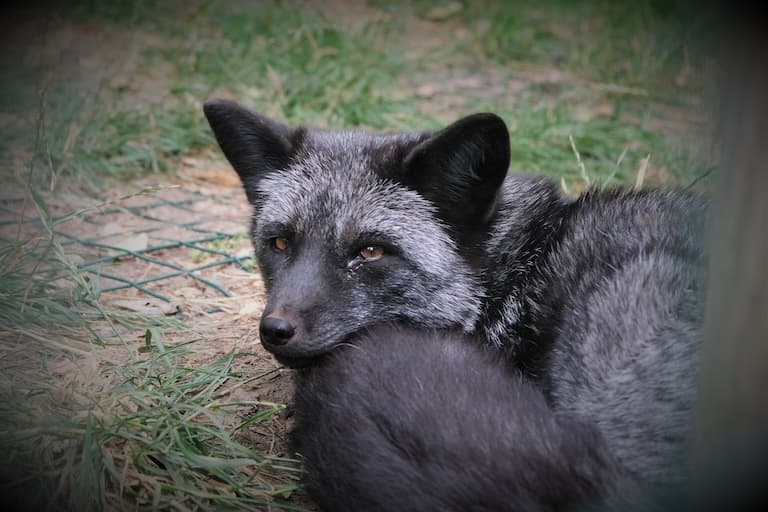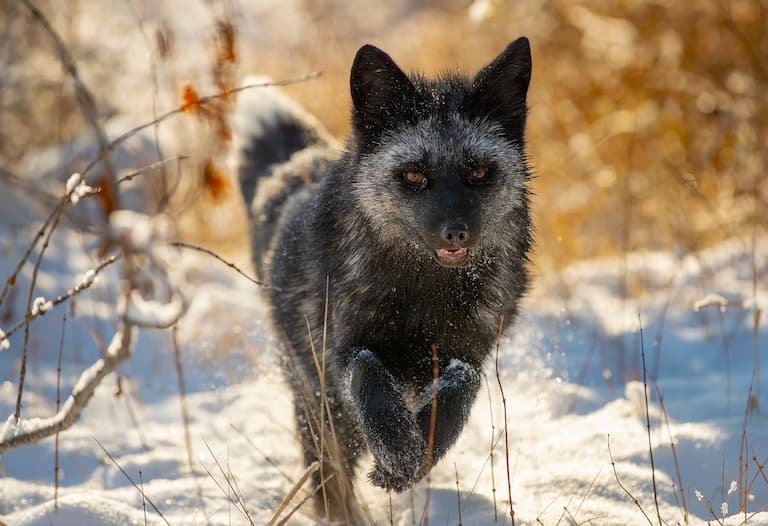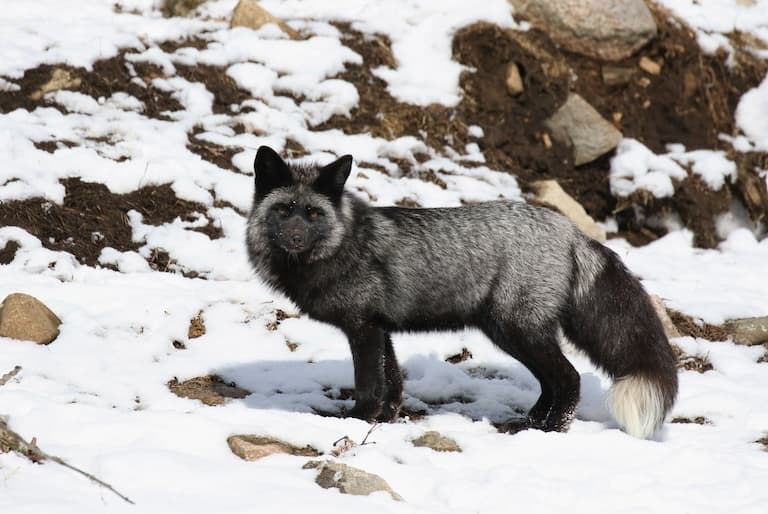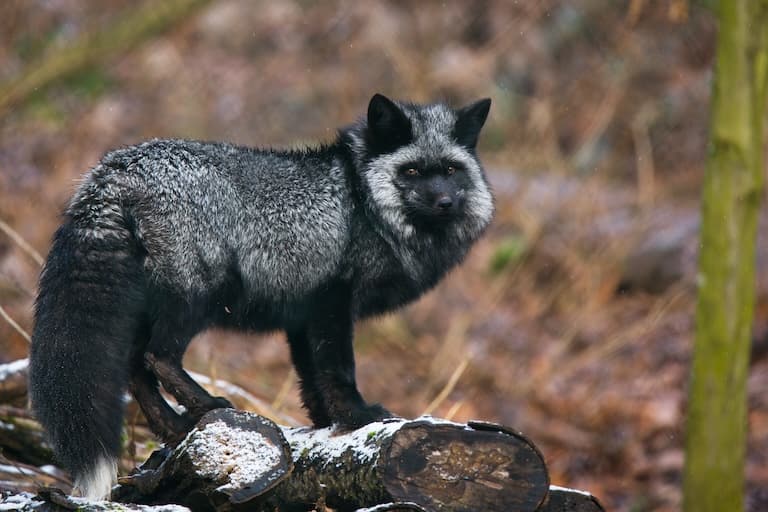Silver Fox Profile
If you’ve ever seen a chimpanzee ripping a red colobus monkey to pieces by hand you have caught a glimpse of the brutality that we humans share with our closest relatives.
These ferocious drives can often trump our sensible appreciation of nature, as they did when humans first saw one of the most striking and beautiful colour morphs of the red fox and thought “I want to rip its skin off and put it on my head”.
The Silver fox is more than just a compliment to Roger Sterling’s cranial accessories; it’s a rare and beautiful mutation that somehow makes Vulpes vulpes even cooler.

Silver Fox Facts Overview
| Habitat: | Mixed forest, tundra, prairie, desert, mountains, farmlands, and urban areas. |
| Location: | Most of the Northern Hemisphere |
| Lifespan: | 3-12 in the wild, 15 in captivity |
| Size: | Up to 90cm (3 ft) long, with a tail that can be 55cm (22 in) in addition |
| Weight: | Up to 9 kg (20 lb) in captivity |
| Colour: | Blue-grey/silver |
| Diet: | Omnivorous, small mammals, fruits, insects, carrion, fish |
| Predators: | Humans, coyotes, wolves, bears |
| Top Speed: | 48 km/h (30 mph) |
| No. of Species: | 1 |
| Conservation Status: | Least Concern |
The majority of biological information about silver foxes is covered by that of red foxes, being, as they are, the exact same species, just with a different coat on.
Sadly, there’s a bunch more to delve into regarding the farming of this morph for its fur, which is an industry that continues predominantly in the US and Russia to this day.
Interesting Silver Fox Facts
1. They’re red foxes
Not all silver foxes are silver: some are black, some are blue-grey, and some are mottled with some combination of related tones.
However, all silver foxes are red, at least genetically. They’re a colour morph of the red fox, Vulpes vulpes, which is already a gorgeous animal, but sometimes mutates into something almost mythical.
This basic mutation, as striking as it is, changes almost nothing about the animal’s DNA, and certainly not enough for it to be considered a subspecies or breed of fox, any more than ginger people should be considered a breed of human.
Melanism is common in the animal kingdom, and this is an example of it. But it comes about in more ways than one. 1

2. There are two mechanisms for the colour morph
Like subatomic particles, genes are only studied by very strange people so they both end up with really weird names. For example, top gene names include Hedgehog, Swiss Cheese and Dreadlocks, and there are even some with a little charm, like Cheap Date and Van Gogh.
Further down the list, you might come across agouti and somewhere near the bottom would be genes like MC1R, which you can’t even pronounce, and these two are the ones known to flicker on and off to create silver foxes.
The Alaskan silver fox has its fur turned dark by a mutation to the MC1R gene, which, unsurprisingly, is one of the key proteins responsible for regulating skin and hair colour in mammals (but also in some birds, and when mutated in humans, makes them less sensitive to anaesthetic for some reason).
The agouti gene codes a signalling protein in hair that competes with a protein that produces dark colours in that hair, so a mutation in this gene prevents that from happening and is responsible for dark colouration in other red fox populations. 2
3. They’re conspicuous
Being beautiful is only a benefit until it isn’t, and having contrasting fur with your environment is often not great as a predator or prey.
The red fox is the most widespread species of any canid, and silver fox mutations are estimated to occur in up to 10% of the population.
This number is significantly less in steppes and deserts, likely because of how conspicuous they would be out in the open, and possibly also because there is already a gorgeous Vulpes species dominating those landscapes in the form of the corsac fox.

4. They’ve been bred to act like dogs
There is a far greater percentage of silver foxes in captivity, as their striking colour has led experiments into their domestication in Russia.
From the ‘50s, they have been bred to be more trusting of humans, more tame, more seeking of validation from their ape overlords and even started wagging their tails.
The classic signs of domestication that are floppy ears and spotted coats also showed up and they have begun to smell less foxy. It sounds as if the whole process could have been skipped since dogs already exist, but people who love using animals as symbols of their originality create a demand for foxes as pets, so the practice continues.
And this isn’t nearly the worst practice these animals have faced. 3 4
5. And to wear
Humans evolved to travel long distances on the African savanna by losing the thick fur of their ancestors and increasing the number of sweat glands in order to keep cool.
Unfortunately, when they arrived in more temperate and cold climates having wandered out of Africa, they found that they should have brought their coat along after all.
Instead of freezing to death, as most other animals would, they wore the coats of the locals.
Fur clothing might be considered as significant a contributor to human expansion around the world as fire, and the necessity of heavy clothing would have given ample opportunity for individualism – the most beautiful and finest furs would have signified status.
So, it’s no wonder that the silver fox was a popular source of such practical fashion, but with the invention of tracksuits and double-glazing, it’s a little harder to justify in the modern world. Yet, it persists.
The playfully alliterate fox fur farms are deceptively malign places. Beginning in Canada in 1895 and numbering close to 500 by the 1920s.
In 2018, there were over 5,000 fur farms, mostly mink and fox, which make up 85% of the fur used in clothing. Four million animals, respectively, are still farmed. These come predominantly from farms in Finland and North America, especially Canada.
6. It’s been pretty bad
Like meat, fur is a luxury item in the developed world, but unlike meat farms, fur farms cater to a wealthy minority, and this makes them a lot easier to object to. Yet, regardless of the hypocrisy, object we should!
There is some irony involved in destroying something because of its beauty, and the silver fox is a great example of it. In the 1800s, they were killed in their thousands by hunters, and their decline in the wild drove farming efforts that have grown into something far worse.
The first farm in Canada began with ten breeding pairs any buy 1913, there were several like it in the same region. This quickly became a multi-million-dollar industry.
Fur farm conditions are truly horrendous for the animals involved, but along with a growing enlightenment to humanity’s responsibility towards the animals we farm, things are getting better, at least in developed nations.
7. Some are being rescued
Huge leaps forward in public awareness, pushed by high-profile protestors in the ‘80s, helped many European countries ban the practice of fur farming in Europe. Still, others continue, and in those areas, there are still people fighting against it.
A former military base in Germany has been converted into a Four Paws animal sanctuary and has a pair of rescued silver foxes from a Polish fur farm whose first experience walking on real earth came after being freed from their small cages and introduced to the park.
They’re described as being exuberant and happy.

Silver Fox Fact-File Summary
Scientific Classification
| Kingdom: | Animalia |
| Phylum: | Chordata |
| Class: | Mammalia |
| Order: | Carnivora |
| Family: | Canidae |
| Genus: | Vulpes |
| Species: | vulpes |
Fact Sources & References
- David L. Fox, “Vulpes vulpes red fox”, Animal Diversity Web.
- Dag Inge Våge (1997), “A non-epistatic interaction of agouti and extension in the fox, Vulpes vulpes”, nature genetics.
- Tim Sandles (2021), “Silver Foxes”, Legendary Dartmoor.
- “SILVER FOXES”, Catty Shack Ranch.
